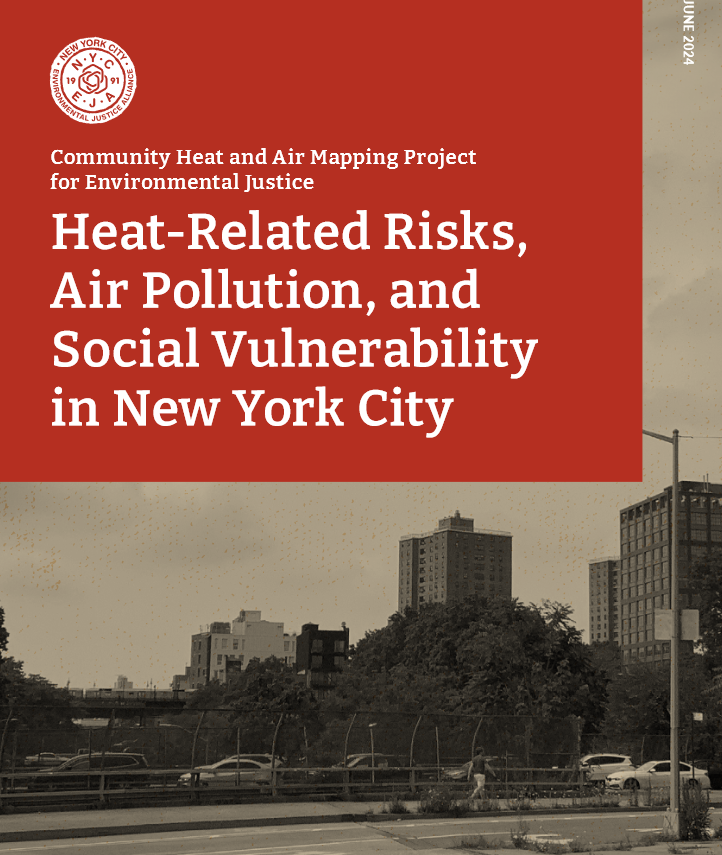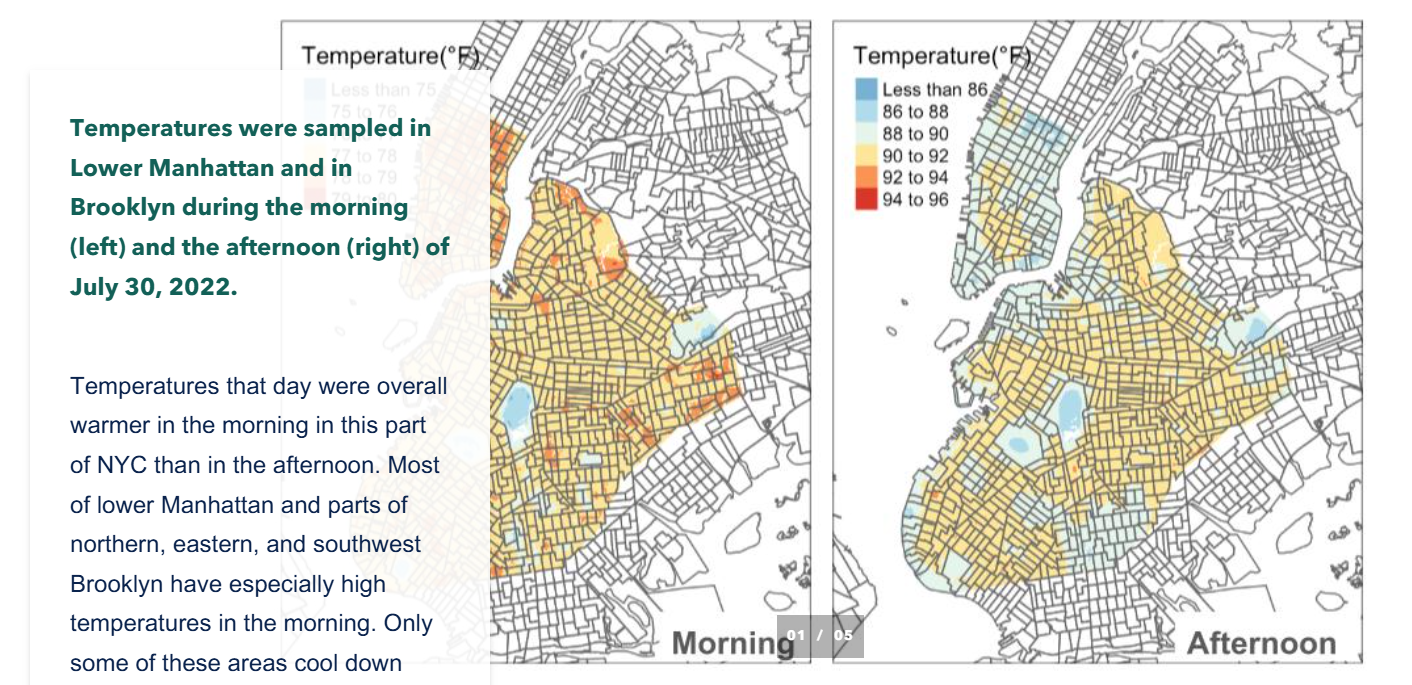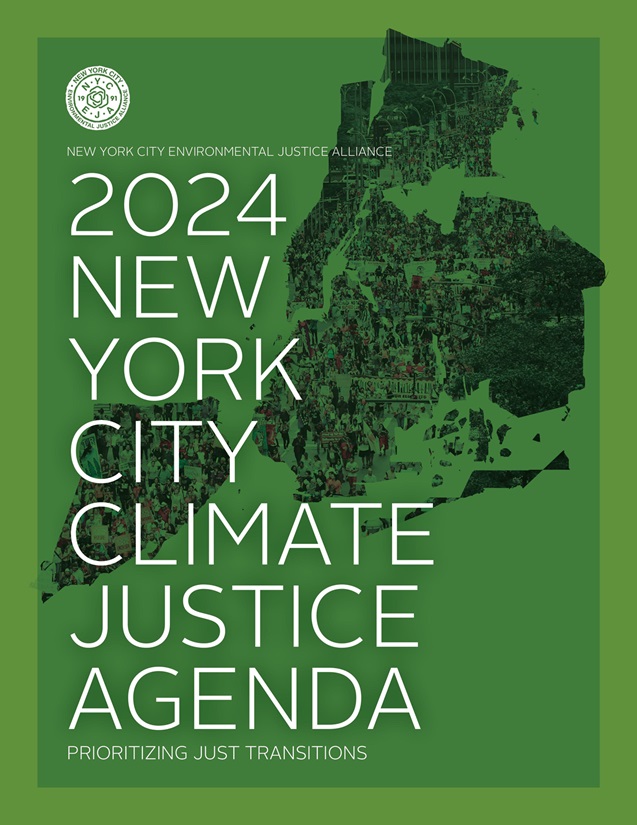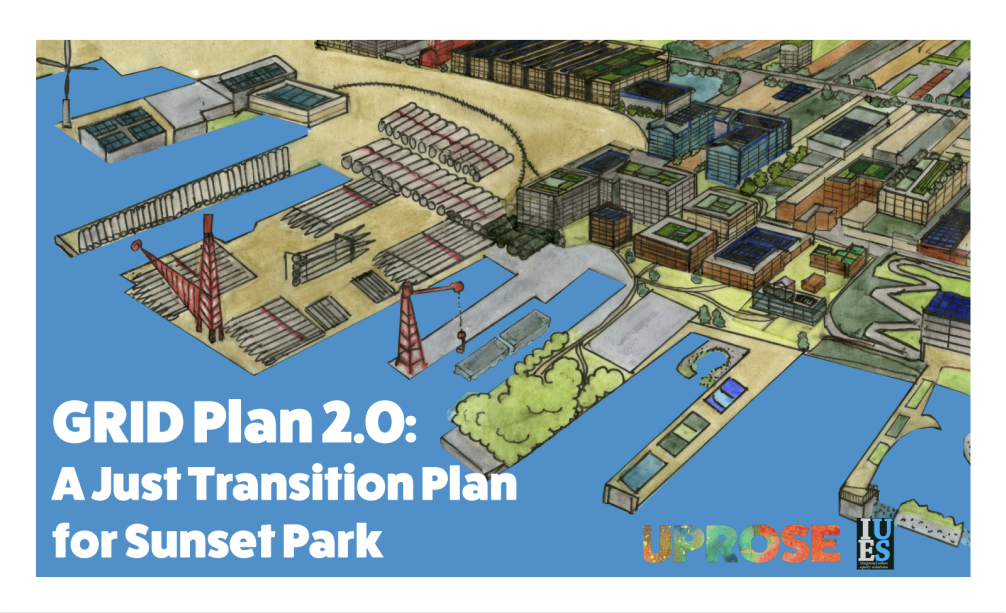Resources
NYC Climate Justice Hub Toolbox (In Progress)
A work-in-progress, the NYC Climate Justice Hub Toolbox offers a supplementary collection of resources produced by the Hub, including information about NYC communities, student projects, research, and data relevant to environmental and climate justice.
Community Library
The NYC-EJA member organizations participating in the NYC Climate Justice Hub have been doing climate justice and social justice work in their communities for centuries—some as early as the 1960s.
Over this period, all of them have produced stories and research that have helped shape climate justice efforts then and now. The Community Library hosts these reports and narratives and is updated as more content is shared.
→ Climate Justice Agenda
→ CAMP-EJ Report
→ Getting LES Ready Report
→ Electrifying Fleets in Hunts Point Report
→ A Critical Decade for Climate, Equity, & Health Report
→ Opportunities for Growth: Nature-Based Jobs in NYC
→ GRID Plan 2.0: A Just Transition Plan for Sunset Park
→ Waterfront Justice Project Map
Climate Justice Agenda (2024)
The 2024 New York City Climate Justice Agenda, a new report from the New York City Environmental Justice Alliance (NYC-EJA), provides community-based guidance on how New York must move forward to address the climate crisis in a meaningful, timely, and equitable manner. The 2024 New York City Climate Justice Agenda arrives when both NYC and NYS governments are floundering in the work of implementing already adopted legislation and policies commensurate with the climate crisis or delaying or backsliding on previous climate justice commitments. It is a solutions-oriented guide for State and City leaders struggling to implement the ambitious climate policies and legislation passed in recent years.
CAMP-EJ Report (2024)
According to the World Health Organization, up to 4.2 million people die prematurely every year due to outdoor air pollution. In New York City, PM2.5 (fine particulate matter) alone is estimated to cause more than 2,000 deaths each year. Meanwhile, as the climate continues to warm the health impacts of heat are becoming clearer and more concerning “[…] and Black New Yorkers are twice as likely to die from heat stress as white New Yorkers.” (CHAMP EJ, p6.) In this session, the researchers will talk about how they got connected, why they felt a partnership was needed and the implications of the report that was generated. They will also discuss the challenges of doing this work and why more equitably structured university-community partnerships are needed in this moment of political division, climate chaos and the pursuit of a just transition.

CAMP-EJ Report (2021)
NYC-EJA’s Community Air Mapping Project for Environmental Justice (CAMP-EJ), a project led by six community-based organizations (CBOs) in the South Bronx and Brooklyn, empowered communities to address rampant air pollution through collecting, visualizing, and leveraging hyperlocal air quality data to improve air quality, public health, and community development. Collectively, El Puente, THE POINT CDC, UPROSE, We Stay/Nos Quedamos, and Youth Ministries for Peace discovered that local facilities/expressways such as the Hunts Point “Toxic Triangle” & the Brooklyn-Queens Expressway are major PM2.5 polluters; air pollution in the South Bronx and Southside Williamsburg peaks in the morning and evening in response to higher traffic volumes (due to congestion and poor transportation infrastructure); and localized air quality measurements recorded pollution levels approx.
20X greater than those reported by the closest state-run monitor. CAMP-EJ’s recommendations include targeted investments/interventions in the South Bronx & Williamsburg to mitigate air pollution; city and state policies to reduce transportation sector pollution in EJ communities; and the prioritization of financial/technical support for hyperlocal air monitoring networks managed by EJ communities.
GOLES’ Getting LES Ready Report (2016)
Created in response to Hurricane Sandy’s devastating impact on NYC, GOLES and The Lower East Side Long Term Recovery Group released this three-part community disaster plan. Part 1 addressed the hurt experienced by impacted residents and small businesses; Part 2 outlined a preparedness and recovery plan for future storms; and Part 3 community-based solutions to mitigate the effects of future disasters. The Getting LES Ready report operates on the knowledge that city services and agencies such as NYCHA were slow to respond to residents’ needs – instead, CBOs and tenant associations led the way.
The report’s recommendation therefore delineated between those responsibilities that City Hall should address and the responsibilities that The Lower East Side Long Term Recovery Group will do themselves. These included recommendations for educating residents on how/when to evacuate or shelter in place; providing direct aid to residents in the aftermath of a disaster; developing contingency plans to ensure supplies, medicines, and other life essentials remain available/are provided to residents; developing communication networks for the quick dissemination of info to affected communities; and the development of informal personal networks through community events so people know each other.
ElectrifyNY’s Electrifying Fleets in Hunts Point Report (2020)
In line with ElectrifyNY’s (ENY) support for electric transportation to reduce fossil fuel usage and improve environmental/public health outcomes, this report provided a policy assessment and roadmap for electrifying medium/heavy-duty vehicles in Hunts Point. Hunts Point is home to the largest food distribution center in NYC and suffers from notoriously poor air quality and high emissions.
Recommendations for ensuring an electric transportation future include the creation of electric charging infrastructure and the development of a workforce trained in the operation and maintenance of electric vehicles. ENY-specific recommendations include disseminating tools to stakeholders to raise knowledge on the state of electrification in Hunts Point, advocating for the inclusion of medium/heavy-duty vehicles in current policies that prioritize light/personal vehicles, new electrification policies that come with their own sources of funding, and lever any public and private connections to advance this agenda.
NYC-EJA’s A Critical Decade for Climate, Equity, & Health Report (2020)
NYC-EJA’s 2020 report assessed OneNYC 2050: Building a Strong and Fair City – the city’s sustainability and resiliency blueprint – in addition to other city and state climate policies (e.g., ). Assessing three goals of reducing harmful greenhouse gasses & localized emissions, advancing a just transition towards an inclusive, regenerative economy, and cultivating healthy & resilient communities, the report views OneNYC 2050 as a good initiative but desperately in need of concrete timelines and ambitious financial and legislative commitments to ensure the achievement of CJ and EJ targets/proper preparation towards future climate hazards and public health emergencies.
NYC-EJA’s Opportunities for Growth: Nature-Based Jobs in NYC report (2021)
Published by Just Nature NYC – a partnership between NYC-EJA and The Nature Conservancy in New York, this report sought to define nature-based jobs (NBJs) and their roles within the NYC labor market. NBJs are defined as jobs that directly contribute to natural infrastructure and nature-based ecosystems with the goal of enhancing human health and well-being and promoting biodiversity. NBJs fall into four job categories – (1) Conceptualization, (2) Implementation, (3) Functional Maintenance, and (4) Value Maintenance – and include a range of occupations such as Foresters, Gardeners, Conservation Scientists, Landscape Architects, and Construction Laborers.
The report also acknowledged a substantial gap between the size of NYC’s natural environment and its capacity to manage it. The report also noted that while the public sector mainly hires NBJs in Functional Maintenance positions that are more deeply representative of nature-based work, the private sector mainly hires for Implementation positions where nature-based activities are deemphasized in day-to-day activities. While NBJs job are expected to grow in the next five years, the report calls for additional investments and public education to underscore the value of nature-based work, particularly in climate-vulnerable communities.
UPROSE’s GRID Plan 2.0: A Just Transition Plan for Sunset Park Report (2023)
Created to counter the processes of gentrification and the pricing out of green businesses in Sunset Park, the GRID 2.0 offers a comprehensive regenerative economic development strategy for the neighborhood. While the timeframe for the updated GRID plan extends to 2035, the GRID presents 28 objectives with implementation strategies that are designed to root a just transition in Sunset Park over the next 12 years. A handful of neighborhoods-wide objectives include employing Sunset Park residents in work designed to strengthen the environment, aligning building contractors under Local Law 97 (i.e., carbon caps), expanding cooperatively-owned community solar across Sunset Park, and greening the manufacturing/industrial, transportation, and residential areas of Sunset Park.
Waterfront Justice Project Map
The Waterfront Justice Project is a collaboration between NYC-EJA and Scaan documenting community vulnerability in the context of climate change impacts, sources of industrial pollution, and demographic and socio-economic trends.New York City’s waterfront policies ease the siting and clustering of public infrastructure, water pollution control plants, waste transfer stations, energy facilities, and heavy manufacturing uses in six areas designated as Significant Maritime and Industrial Areas (SMIAs). The SMIAs are located in environmental justice communities, largely low-income communities and communities of color, in the South Bronx, Brooklyn, Queens, and Staten Island. New York City’s local waterfront land use and zoning policies create cumulative risk exposure not only to residents and workers in the host waterfront communities, but also, in the event of storm surge or sea-level rise, to neighboring, upland communities.








